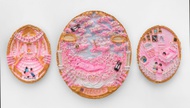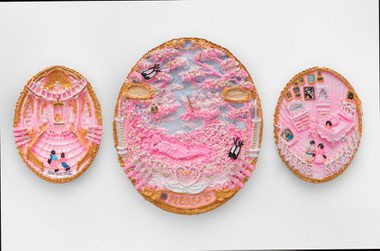The artist Frank James is precise. Very precise. Set your watch by him precise. I suspect this right away when I manage to arrive at his door exactly at 10 a.m.—a rarity for me—and he notes my punctuality with a smile of relief. “You’re right on time.”
But moments later, I know it beyond all doubt. In the living room of James’ North Las Vegas home are three tables; and on these three tables are scale models, each about the size of a footlocker, that James assembled by hand: a church, a house and the Tabernacle of Moses.
The church, probably the most accomplished piece of the three, he calls the Universal Temple of Truth. It’s not based on a real church, but its attention to details across the façade, in the interiors, seems to belie this. He notes that it took him 8,900 hours to create. (If you really want to split hairs, 8,985.) That’s a year plus five days, working 24/7, though James completed it over the course of four years.
How does he even know this? I ask.
He kept a log.
His sense of precision is matched only by his inventiveness. All three models are symphonies of discarded bits and pieces, debris, ephemera, waste, reimagined and re-created. The tiny candles inside the church were made from drinking straws. The stainless glass was made by baking pieces of colored plastic from toys into an already-soldered window framework. Pen holders serve as miniature floodlights. The small clock on the church tower strikes every hour. The work rests on a cross-shaped table; the table itself has a CD player built in that plays gospel music.
More
- Related Story
- Call it ‘American art’ (08/13/09)
Next to the church is the House of Democracy (5,800 hours). Less refined than the church, the two-story house is a big sunny idealization of the American dream. It sits at the corner of Faith Avenue and Freedom Street. The streetlights, capped with toothbrush cases, work. The Jacuzzi, made from an ice-cream dish, bubbles at the touch of a button. Thumbtacks hold the telephone lines on the street. In one room are miniature portraits of Martin Luther King, John F. Kennedy and Abraham Lincoln (the latter’s face taken from the $5 bill).
And so it goes. Little chairs are made from artfully snipped and shaped pieces of wire hanger, painted white. The white picket fence is made out of Popsicle sticks, the pool in back fashioned from a plastic trash container. Planters are made from perfume caps.
The third table presents the Tabernacle of Moses (7,000 hours), the sacred wilderness tent where God communicated with the Israelites through their wandering the desert. This is more like an elaborate diorama presented into a long and thin box that opens (thanks to hydraulic arms cribbed from his Nissan 280ZX). The roof of the box depicts a starry night scene; the ground shows the tabernacle itself, surrounded by dirt James says comes from Israel. The tabernacle is ringed by small oil lamps that James fashioned from cigarette lighters. Underneath the table is a small gas tank and little pipes.
James, 62, is from Trinidad. He says he “grew up in the bush,” working from a young age fishing and shucking sugar cane. He came to America to help care for his brother’s kid. America, he says, “took me and taught me.” He learned masonry, plumbing. He can fix watches, make shoes. He made his first wife’s wedding dress and the wedding cake. He moved to Las Vegas 14 years ago and worked for Richardson Construction. “The only thing I haven’t done is figure out how to fix an airplane.”
There’s only one problem for the artist. Well, two. The first has been getting his work out there. It’s hard to find a venue to exhibit his work. He’s gotten a grant or two, but they’re peanuts. Perhaps there’s something about the miniatures—they way they challenge our assumptions about what art is. Is James an artist or merely a craftsman or hobbyist? The question seems to have less to do with his skill or ambitions and more to do with a narrow-minded view of art.
In describing his art, James notes that he “destroys things to make things.”
These miniatures are old, too. The house is 27 years old. The church is 25 years old. The tabernacle, 17. He exhibited them at the West Las Vegas Library Theater 15 years ago. He also exhibited once at Boulder City Library and at Dallas City Hall, when he briefly lived in Texas. But that’s been about it. “Nobody will give me help in this town. I don’t think it’s a cultural town.”
Why so long?
James’ second problem is probably deeper and may go toward answering that question. These intricate creations of his take time. They’re expensive. They seem to deplete him at least as significantly as they excite him. For all the pride he takes in his work—he sells postcards and posters of the miniatures—there is more than a touch of ambivalence. For him, his talent is something of a burden. It demands his constant attention. “They take all my time and all my money,” he says. “I drag these houses around wherever I go.”
Moments later he adds, “I’m tired. I’ve had them so long I want to get rid of them. They’re like kids who never leave home.”
But just when you think the gloomy side will win out, excitement bubbles out of James. He wants to do a replica of the World Trade Center, which would have a table of wood shaped like New York City below a pair of hands supporting another tabletop, shaped like Manhattan, upon which would rise a 42-inch version of the Twin Towers. “Twins in the Hands of God” is the title.
He’s hoping an upcoming exhibit at UNLV draws interest in his work. Maybe some funding. “Somehow I will build the twin towers memorial. It will be the most wonderful memorial.”








Previous Discussion: